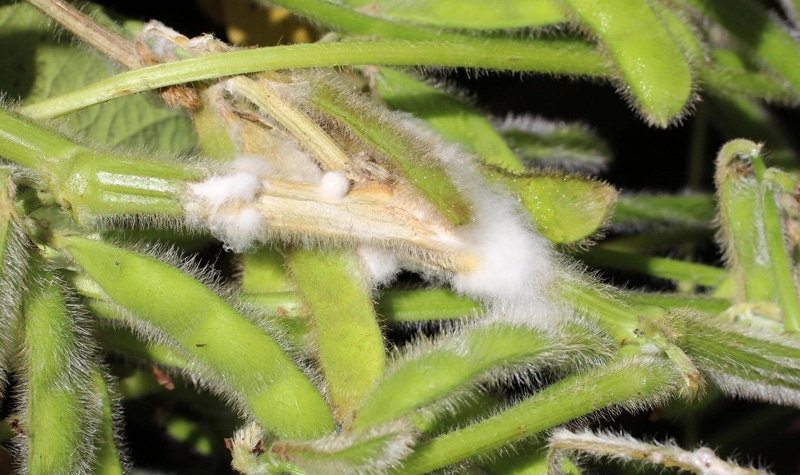August 12, 2016

A few soybean fields have been found with white mold just starting to develop. White mold symptoms begin after soybean flowering, when the spores produced by the white mold pathogen land on the senescing flowers.
White Mold Symptoms
Visible canopy symptoms of white mold include grayish pale green leaves followed by necrosis. The early symptoms can be mistaken for other diseases such as brown stem rot, stem canker or sudden death syndrome. A closer look at infected plants in the middle canopy reveals typical signs of the white mold pathogen - white mycelia and possible sclerotia (black spherical bodies) on the lower stem nodes (Figure 1).
As symptoms advance, the fungus girdles the entire stem increasing above and below the infection point, leading to wilting. Infected stems are bleached and die prematurely and such plants will have reduced pod fill above the lesion. Side branches, petioles and pods can also be infected especially if they are in contact with infected stems. Plants with advanced symptoms of white mold have sclerotia that looks like mouse droppings. Because white mold occurs in patches, symptoms are sometimes missed or mistaken for normal soybean maturity until harvest, when infected portions of the field have poor yield.
Causes
White mold is caused by the fungus Sclerotia sclerotiorum. The fungus overwinters as sclerotia which can survive on the soil surface up to three years. Sclerotia within the top 2 inches of the soil germinate forming small cup-shaped mushrooms called apothecia when the soil is shaded (from canopy closure, cloudy or foggy weather) and canopy temperatures are 40-60° F. These tiny mushrooms produce millions of spores called ascospores and infection begins when these land on a senescing flower. Prolonged air temperatures below 85° F and frequent rains providing more than 42 hours of continuous wet stem surfaces or more than 12 hours of surface wetness on a daily basis promote white mold infection. Cultural practices that favor early canopy closure and lush growth, such as narrow row spacing, high fertility (especially from animal manure), and high plant populations increase the risk for white mold development.
Management Tips
White mold is best managed by avoiding practices that increase the risk of the disease. By the time symptoms are observed, it is too late to apply a rescue treatment. For fields with a history of white mold and an environment conducive to white mold development, a well-timed fungicide at soybean flowering can be effective in controlling the pathogen. Use flat-fan spray nozzles to improve mid-canopy coverage. Some of the fungicides with good white mold control include picoxystrobin (Aproach), flutriafol (Topguard), prothioconazole (Proline), tetraconazole (Domark), thiophanatemethyl (Topsin-M, other generics), and boscalid (Endura).
Use the following practices to proactively manage white mold in future soybean seasons:
· Select cultivars with tolerance to white mold; some seed companies provide ratings for soybean cultivars against white mold.
· Crop rotation helps break the pathogen life cycle. Care should be taken when selecting crops to rotate with soybeans. Most broadleaf crops such as alfalfa, sunflower, dry beans, are also hosts of white mold. Small grains and corn are good non-host crops for white mold. For fields with a history of white mold epidemics, a 2-3 year rotation away from soybeans is recommended. Each year the number of viable sclerotia decreases especially if the field is under no-till.
· Deep tillage to bury sclerotia helps prevent them from developing mushrooms. However, after deep tillage in subsequent seasons care should be taken to prevent bringing buried sclerotia back near the soil surface, as sclerotia can survive more than 3 years underground.
· Wide row spacing of more than 20 inches helps delay canopy closure and prevents sclerotia from developing into mushrooms. However white mold can develop in a wider row spacing if favorable weather is experienced after canopy closure.
· Fertility programs that use animal manure in fields with a history of white mold should be avoided. Animal manure tends to encourage quick lush growth which favors white mold development.
· Some biological control agents do provide some level of white mold control. A common commercial biological control agent is Contans. This product is incorporated into the soil in fall or spring. It contains another fungus that feeds on and destroys the white mold sclerotia. There is better control of white mold with repeated use of the product.
· Practice a good weed control program. Several broadleaf weeds such as lambsquarters, chickweed, field pennycress, velvet leaf and others are hosts for white mold.
You May Also Like




